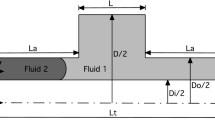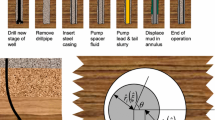Abstract
Construction of wells for oil production, geothermal energy recovery or geological storage of carbon dioxide is performed in stages by drilling the rock formation to a certain vertical depth, and then isolating the drilled section by running and cementing a casing string in the hole. The conventional cementing strategy relies on displacing the annular space behind the casing from the bottom and toward the surface. The conventional circulation direction therefore places the denser cementing fluids below the original annular fluid. An alternative cement placement strategy is to displace the annular space from the surface and downward by injecting cementing fluids directly into the annulus. Such reverse circulation operations have the benefit of lower circulation pressures and a reduced risk of fracturing the formation during placement, but also leads to density-unstable displacement conditions and increased risk of fluid contamination. To better understand how the design of cementing fluids and their placement rate affect reverse circulation displacements, we performed a series of computational simulations of density-unstable displacements using a realistic three-dimensional geometrical model of a wellbore annulus. We address the effects of wellbore inclination and inner pipe eccentricity, with a particular focus on impacts of the fluid viscosity hierarchy on the annular displacement efficiency. Our results show that increasing the displaced fluid viscosity will act to suppress the tendency for buoyant backflow, while it can worsen displacement of the narrow side of the eccentric annulus. Transverse secondary flows, which are stronger in cases where the displaced fluid is less viscous, contribute to the displacement of the narrow, low side of the annulus. We also observe that increasing the imposed axial velocity will tend to stabilize the annular displacement and suppress backflow, in agreement with previous work for buoyant pipe displacements. The present computational study is a step toward understanding how buoyant, inertial, and viscous stresses affect density-unstable displacement flows for reverse circulation cementing.
Access this chapter
Tax calculation will be finalised at checkout
Purchases are for personal use only
Similar content being viewed by others
References
Benjamin, T.B., Gravity currents and related phenomena. Journal of Fluid Mechanics, 1968. 31(2): p. 209-248.
Shin, J., S. Dalziel, and P. Linden, Gravity currents produced by lock exchange. Journal of Fluid Mechanics, 2004. 521: p. 1-34.
Hallez, Y. and J. Magnaudet, A numerical investigation of horizontal viscous gravity currents. Journal of Fluid Mechanics, 2009. 630: p. 71-91.
Skadsem, H. and S. Kragset, A Numerical Study of Density-Unstable Reverse Circulation Displacement for Primary Cementing. Journal of Energy Resources Technology, 2022. 144.
Guillot, D. and E. Nelson, Well cementing. Schlumberger Educational Services, Sugar Land, TX, 2006.
McNerlin, B., et al. Open Hole Fluid Displacement Analysis-Forward vs. Reverse Circulations. in SPE Annual Technical Conference and Exhibition. 2013. OnePetro.
Macfarlan, K.H., et al., A Comparative Hydraulic Analysis of Conventional-and Reverse-Circulation Primary Cementing in Offshore Wells. SPE Drilling & Completion, 2017. 32(01): p. 59-68.
Griffith, J., D. Nix, and G. Boe. Reverse Circulation of Cement on Primary Jobs Increases Cement Column Height Across Weak Formations. in SPE Production Operations Symposium. 1993. Society of Petroleum Engineers.
Walton, I. and S. Bittleston, The axial flow of a Bingham plastic in a narrow eccentric annulus. Journal of Fluid Mechanics, 1991. 222: p. 39-60.
Roustaei, A. and I. Frigaard, Residual drilling mud during conditioning of uneven boreholes in primary cementing. Part 2: Steady laminar inertial flows. Journal of Non-Newtonian fluid mechanics, 2015. 226: p. 1–15.
McLean, R., C. Manry, and W. Whitaker, Displacement mechanics in primary cementing. Journal of petroleum technology, 1967. 19(02): p. 251-260.
Tehrani, A., J. Ferguson, and S. Bittleston. Laminar displacement in annuli: a combined experimental and theoretical study. in SPE annual technical conference and exhibition. 1992. OnePetro.
Tehrani, M., S. Bittleston, and P. Long, Flow instabilities during annular displacement of one non-Newtonian fluid by another. Experiments in Fluids, 1993. 14(4): p. 246-256.
Drazin, P.G. and W.H. Reid, Hydrodynamic stability. 2004: Cambridge university press.
Sharp, D.H., An overview of Rayleigh-Taylor instability. Physica D: Nonlinear Phenomena, 1984. 12(1-3): p. 3-18.
Séon, T., Du mélange turbulent aux courants de gravité en géométrie confinée. 2006, Université Pierre et Marie Curie-Paris VI.
Séon, T., et al., Buoyancy driven miscible front dynamics in tilted tubes. Physics of fluids, 2005. 17(3): p. 031702.
Seon, T., et al., Front dynamics and macroscopic diffusion in buoyant mixing in a tilted tube. Physics of Fluids, 2007. 19(12): p. 125105.
Etrati, A., K. Alba, and I.A. Frigaard, Two-layer displacement flow of miscible fluids with viscosity ratio: Experiments. Physics of Fluids, 2018. 30(5): p. 052103.
Eslami, A., S. Akbari, and S. Taghavi, An experimental study of displacement flows in stationary and moving annuli for reverse circulation cementing applications. Journal of Petroleum Science and Engineering, 2022. 213: p. 110321.
Ghorbani, M., et al. Computational fluid dynamics simulation of buoyant mixing of miscible fluids in a tilted tube. in IOP Conference Series: Materials Science and Engineering. 2021. IOP Publishing.
Ghorbani, M., A. Royaei, and H.J. Skadsem, Reverse circulation displacement of miscible fluids for primary cementing. Journal of Energy Resources Technology, 2023: p. 1–19.
Skadsem, H.J., et al., Study of ultrasonic logs and seepage potential on sandwich sections retrieved from a North sea production well. SPE Drilling & Completion, 2021. 36(04): p. 976-990.
Gorokhova, L., A. Parry, and N. Flamant, Comparing soft-string and stiff-string methods used to compute casing centralization. SPE Drilling & Completion, 2014. 29(01): p. 106-114.
McSpadden, A.R., O. Coker III, and G.C. Ruan, Advanced casing design with finite-element model of effective dogleg severity, radial displacements, and bending loads. SPE Drilling & Completion, 2012. 27(03): p. 436-448.
Cook, A.W. and P.E. Dimotakis, Transition stages of Rayleigh–Taylor instability between miscible fluids. Journal of Fluid Mechanics, 2001. 443: p. 69-99.
Hallez, Y. and J. Magnaudet, Effects of channel geometry on buoyancy-driven mixing. Physics of fluids, 2008. 20(5): p. 053306.
Author information
Authors and Affiliations
Corresponding author
Editor information
Editors and Affiliations
Appendix 1
Appendix 1
We performed a grid sensitivity study to ensure the results were not significantly influenced by the chosen grid resolution. The simulation with parameters Fr = 5.15 and Re = 283 and an eccentricity of e = 0.3 was run with four different grid sizes, denoted coarse, medium, fine and extra fine. The total number of cells was doubled for each level, where fine corresponds to the grid resolution used in the remainder of the work.
Figure 13 shows the gap-averaged concentration field after 8 s. The overall evolution is almost identical for all resolutions, indicating that the fine resolution is satisfactory. This is further corroborated by the calculated front velocity and total displacement efficiency (ratio of displacing fluid volume and total annulus volume), which are shown in Fig. 14. Again, the results are not significantly influenced by the grid resolution.
Rights and permissions
Copyright information
© 2024 The Author(s), under exclusive license to Springer Nature Switzerland AG
About this paper
Cite this paper
Ghorbani, M., Giljarhus, K.E.T., Skadsem, H.J. (2024). Influence of Viscosity on Density-Unstable Fluid-Fluid Displacement in Inclined Eccentric Annuli. In: Pavlou, D., et al. Advances in Computational Mechanics and Applications. OES 2023. Structural Integrity, vol 29. Springer, Cham. https://doi.org/10.1007/978-3-031-49791-9_20
Download citation
DOI: https://doi.org/10.1007/978-3-031-49791-9_20
Published:
Publisher Name: Springer, Cham
Print ISBN: 978-3-031-49790-2
Online ISBN: 978-3-031-49791-9
eBook Packages: EngineeringEngineering (R0)






